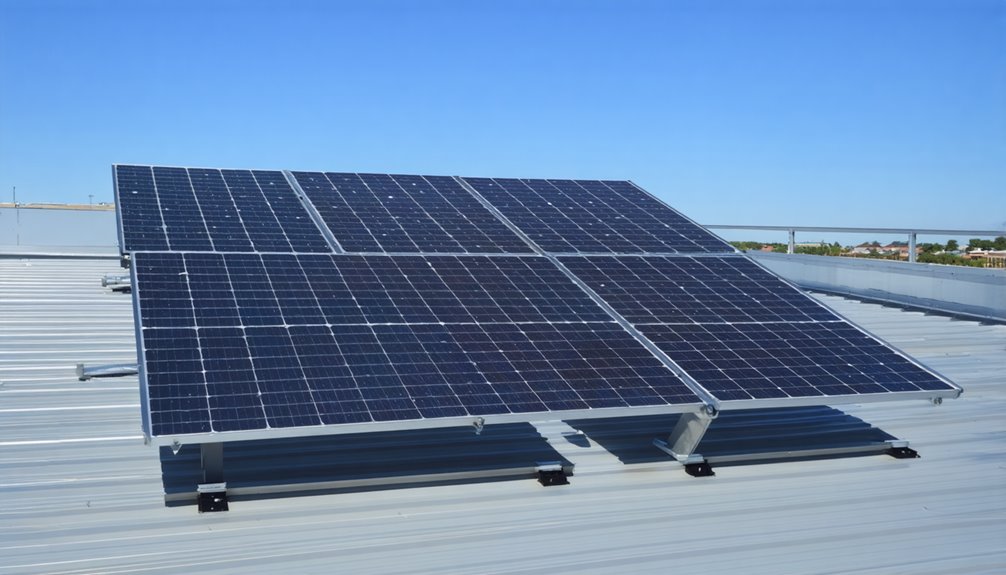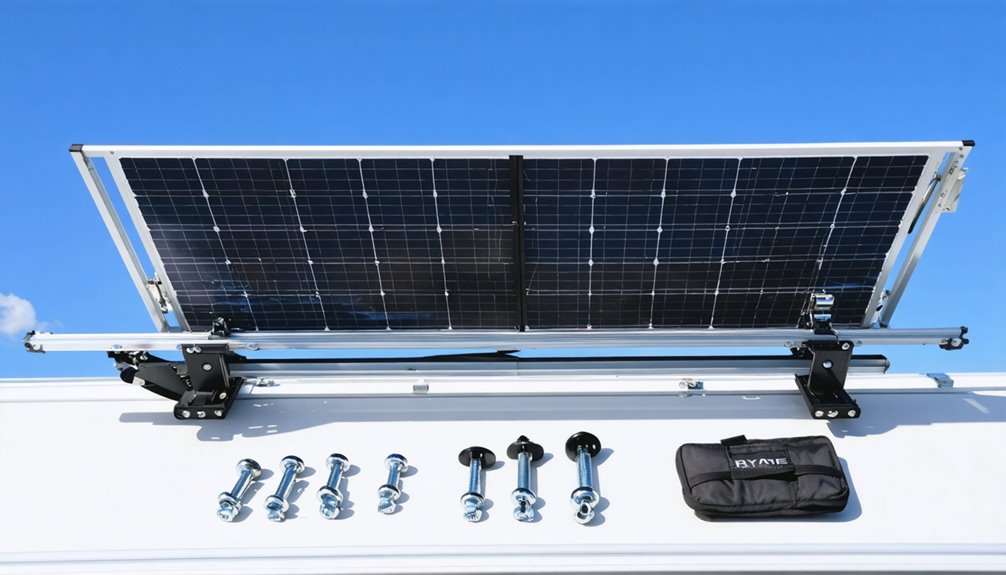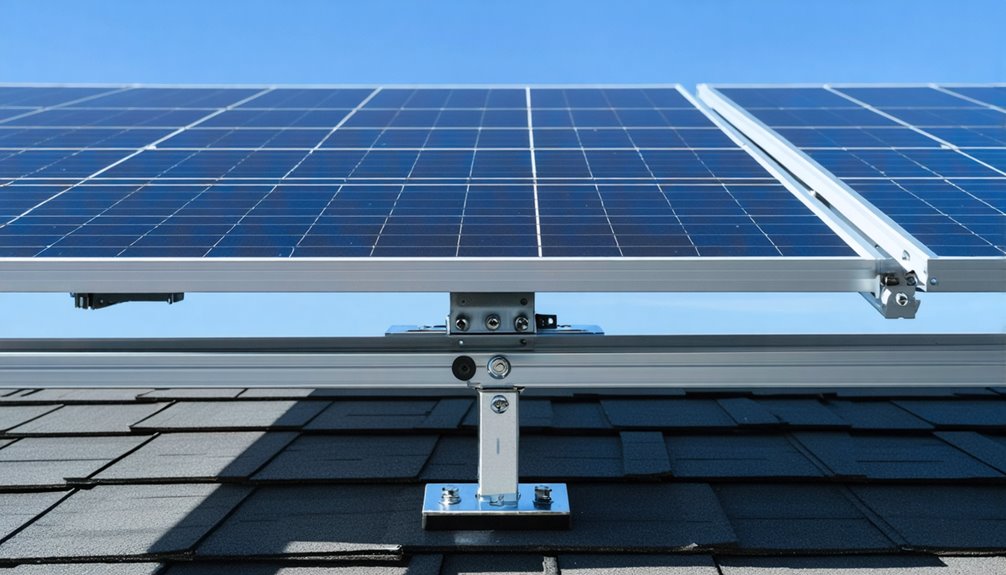Selecting and setting up solar panel tilt mounts involves optimizing panel angles for maximum sunlight capture, with efficiency gains up to 25% over fixed mounts. You should consider adjustable brackets, durable materials like aluminum, and secure fastening to withstand weather conditions. Guarantee the roof’s south-facing orientation and examine its condition, stability, and material. Leading brands like IronRidge offer robust solutions, while professional installation guarantees safety. Consider cost factors including mounts, additional hardware, and installation. Explore further for thorough details.
Understanding Solar Panel Tilt Mounts
Solar panel tilt mounts, an important component in solar energy systems, revolutionize how solar panels capture sunlight by allowing them to be adjusted to ideal angles. Consider seasonal tilt options to adapt to winter and summer sun paths, using adjustments aligned with your latitude seasonal tilt options. These adjustable mounting systems can markedly enhance energy efficiency, increasing it by up to 25% compared to fixed mounts. By optimizing the tilt angle, you guarantee that solar panels receive maximum sunlight, essential for effective solar energy generation. Installation of these mounts is versatile, suitable for rooftops, RVs, and boats, consequently providing adaptability for off-grid solar systems. The Newpowa Adjustable Solar Panel Tilt Mounts, designed for 40-100 watt panels, exemplify compact, efficient design with a 20-inch width. Proper installation is fundamental; secure fastening ensures stability, enhancing both energy capture and maintenance access without panel detachment.
Key Components of Solar Panel Tilt Mounts
A harmonious balance between solar panel positioning and structural integrity offers a pathway to maximizing energy efficiency; understanding this balance starts with grasping the key components of solar panel tilt mounts. This selection also emphasizes weather resistance to withstand diverse weather conditions. Central to solar panel mounting systems are the adjustable brackets that permit angle adjustments, essential for optimizing solar panel efficiency and boosting energy capture by up to 25%. These tilt mounts rely on rugged construction materials, like aluminum or stainless steel, ensuring durability against diverse weather conditions. During installation, secure the mounts to flat surfaces using elements such as L-feet bolted to roof rafters, maintaining stability and alignment. Additionally, tilt mounts cater to solar panels ranging from 40-100W, serving applications from RVs to marine environments, offering flexible, efficient energy solutions.
Assessing Roof Compatibility for Tilt Mount Installation
When you’re evaluating roof compatibility for tilt mount installations, it’s crucial to examine the roof’s condition since any existing damage can jeopardize both the stability of the mounts and the solar panel system. Additionally, consider the roof’s orientation; a south-facing orientation typically maximizes sunlight exposure, enhancing energy efficiency. Finally, factor in local weather conditions, including wind and snow loads, as these can considerably affect the choice of mounts and installation requirements, ensuring long-term reliability and performance.
Roof Condition Assessment
Before proceeding with the installation of tilt mounts for solar panels, it is vital to thoroughly assess the roof’s condition to guarantee compatibility and safety. A detailed roof condition assessment starts with examining the structure’s integrity, as any damage or weakness can jeopardize the solar panel installation’s safety. Consider the roofing materials used; different materials like asphalt shingles, metal, or tile require specific roof mounts for secure installation. Evaluating local weather patterns, high winds, or snow loads is significant, impacting the performance and durability of the tilt mounts. Analyzing the roof’s slope is imperative, as tilt mounts can boost energy production on steeper pitches, though excessively steep roofs may necessitate additional safety measures and strategic planning for maximum efficiency.
Orientation for Efficiency
Maximizing efficiency in tilt mount installations for solar panels hinges on understanding the vital role of roof orientation, which greatly influences energy production potential. Evaluating roof compatibility involves examining orientation, where south-facing roofs offer the highest solar energy output due to ideal sun exposure. The panel angle should match the roof’s incline, ideally correlating with your location’s latitude, ensuring the solar installation captures sunlight effectively. Flat roofs provide a unique advantage; their adaptive tilt mounts can boost solar panel efficiency by up to 25% over fixed setups. Finally, confirming the roof’s structural integrity is essential, as it must support the weight and stress of tilt mounts and panels, ensuring a durable, long-lasting installation.
Weather Impact Evaluation
Although the orientation of your roof is a vital factor in evaluating its suitability for tilt mount installations, weather impacts can’t be overlooked, as they play a significant role in determining both the efficiency and longevity of your solar panels. Weather conditions, including local wind speeds and snow loads, must be factored in, as they affect the structural integrity and safety of your solar panels. Understanding local climate patterns helps determine the ideal tilt angles for maximum efficiency across seasons. Adhering to safety regulations specific to your area is essential, as these guidelines are often influenced by weather-related factors. Additionally, evaluating the condition of your roofing material is important, since deteriorating roofs necessitate repairs to support the long-term stability of tilt mounts effectively.
Benefits of Adjustable Solar Panel Tilt Mounts

Benefits of Adjustable Solar Panel Tilt Mounts
With adjustable solar panel tilt mounts, you can enhance energy production by aligning your panels for maximum sunlight exposure throughout the day, potentially boosting efficiency by up to 25%. Considering adjustability alongside durability helps ensure the mounting system adapts to different angles and conditions over time. These mounts not only accommodate a range of panels from 40-100W, but their compact design also guarantees efficient space utilization, making installation on flat surfaces straightforward. Additionally, the sturdy construction provides reliable support across various environments, ensuring long-term performance and maintenance ease, whether you’re using them on RVs, roofs, or boats.
Enhanced Energy Production
When solar panels are installed using adjustable tilt mounts, energy production can see a significant boost, increasing by up to 25% as these mounts enable perfect positioning of panels towards the sun throughout the day. By adjusting solar panels to prime angles, you can maximize energy production through effective mounting solutions, especially on flat surfaces that often limit performance efficiency.
| Benefits | Description |
|---|---|
| Enhanced Energy Yield | Prime angles capture more sunlight efficiently. |
| Seasonal Adjustments | Maximize energy as sun’s position shifts yearly. |
| Access for Maintenance | Easier upkeep improves longevity of the system. |
| Off-Grid Solutions | Perfect for remote areas boosting energy reliability. |
Adjustable tilt mounts can finely tune panel angles to harness more sunlight during various times, capturing the lower-angled rays in mornings and evenings, leveraging these mounts enhances overall system performance.
Optimal Sunlight Exposure
Adjustable solar panel tilt mounts play a significant role in maximizing sunlight exposure, ensuring that solar panels maintain a favorable angle throughout the year to enhance energy production. By adapting the tilt angle according to the sun’s position, these mounts capture more direct sunlight, potentially boosting efficiency and solar energy output by up to 25%. This capability is particularly advantageous in varied installation environments, including roofs, RVs, and boats, where ideal sunlight exposure is essential. With configurable designs, these mounts not only facilitate effective energy production but also provide easy maintenance access, ensuring panels remain clean and efficient. By aligning the tilt angle with local solar patterns and seasonal changes, you can fully harness solar energy benefits, enhancing overall energy efficiency throughout the year.
Efficient Space Utilization
While incorporating adjustable solar panel tilt mounts, you optimize space utilization by aligning panels effectively within limited areas. These solar mounting solutions boost energy efficiency by up to 25% through the strategic angling of panels toward the sun, optimizing solar exposure during varied sunlight conditions. Versatile in design, such mounts cater to different surfaces, from roofs to RVs and boats, accommodating compact spaces without compromising functionality. Installation of these mounts reduces shading and improves access for maintenance, easing cleaning and repairs. Systems like the Newpowa Tilt Mount Kit support solar panels in the 40-100W range, proving adaptable for small-scale setups. By facilitating efficient space use, these mounts enhance performance, making them a practical choice for many off-grid applications.
Choosing Suitable Brands for Solar Panel Tilt Mounts
In your quest to choose suitable brands for solar panel tilt mounts, focus on evaluating key players like IronRidge and Unirac, as they stand out for their durable and innovative solutions tailored to diverse roof types and environmental conditions. Their products offer various types of racking, including adjustable solar panel tilt mounts, accommodating differences in solar panel racks and installation requirements. These brands provide high-quality solar solutions, guaranteeing your panels perform effectively. For ideal alignment with solar panel wattage, adjustable brackets cater to different panel sizes. When considering installation, opting for a licensed solar installer guarantees the mounts are installed correctly and safely, reflecting their long-term warranty assurances. This thorough approach ensures you’ll achieve a well-fitted, efficient solar energy system. Additionally, understanding the structural load and how wind and snow impact mounting helps prevent failures over time structural load.
Steps to Install Solar Panel Tilt Mounts
To commence the installation of solar panel tilt mounts, selecting an appropriate location is crucial, as this guarantees ideal sun exposure and system stability, which are essential for maximizing energy efficiency. Additionally, perform a quick structural assessment to confirm the surface can safely support the anticipated loads structural assessment. Begin by securing the tilt mount brackets to your chosen site, ensuring proper hardware is used to create a watertight seal. For ground-mounted solar panels, firmly attach the brackets to the surface for maximum support. Next, adjust the tilt angle of your solar array so it effectively captures solar energy, which can improve efficiency by up to 25%. Attach the solar panels to the mounting brackets with clamps, ensuring they’re securely fastened to withstand adverse weather. Finally, inspect all electrical connections and confirm wiring is safely contained in conduits to the inverter.
Cost Considerations for Solar Panel Tilt Mounts

Balancing the initial outlay for solar panel tilt mounts with potential efficiency gains can profoundly impact your overall solar system budget. Cost considerations begin with adjustable solar panel tilt mounts, typically priced between $50 and $200, depending on the materials, design, and panel compatibility. Installation costs can add another 10-15% to your budget, especially when employing professional installers to guarantee peak functionality and safety. Despite these expenses, the potential for up to a 25% increase in energy efficiency can validate the investment, boosting energy production. It’s important to account for additional expenses, like installation hardware—such as clamps and rails—not always included in the package. Tailored for solar panels ranging from 40-100 watts, these mounts are suited for RVs, rooftops, and boats, aligning cost with specific applications.
Conclusion
By understanding solar panel tilt mounts and evaluating roof compatibility, you can select and install the most suitable system to maximize solar efficiency. Consider the key components and benefits of adjustable mounts to enhance energy output. Researching reliable brands and understanding cost implications ensures informed decision-making. Following systematic installation steps will secure longevity and performance of your solar panels, effectively reducing energy costs while promoting sustainable practices. Thorough evaluation remains essential for optimal solar panel system performance.
When sourcing mounting systems, selecting suppliers with proven expertise and quality standards is crucial for project success. Solocity Global serves as a trusted exporter of solar panel mounting systems, providing high-quality, standards-compliant mounting solutions to clients across international markets.


